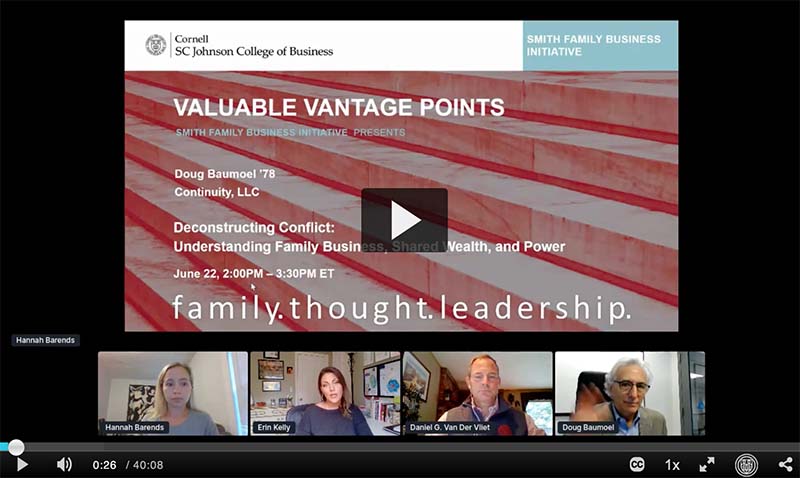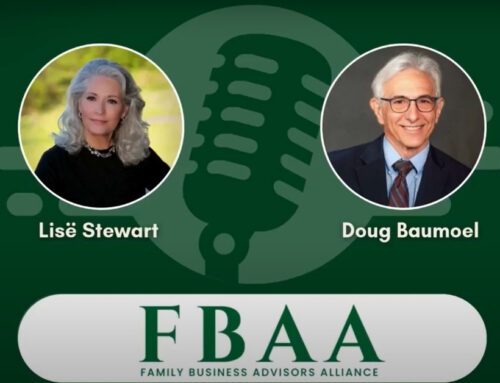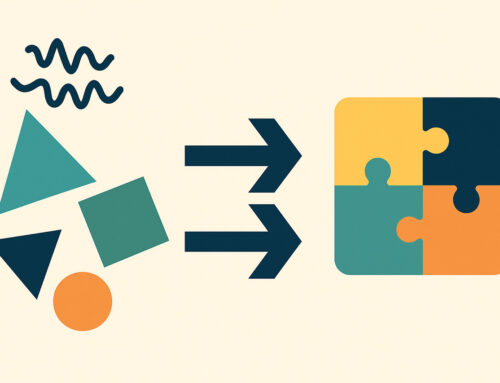In this video, Continuity Founding Partner Doug Baumoel shares 5 foundational concepts to help viewers better understand and manage the unique type of conflict that happens when families work and own together. This recent event was hosted by the Smith Family Business Initiative at Cornell University.
Watch this video and you’ll learn:
- The reasons that underline all conflict
- Triggers that activate conflict
- How to manage and avoid it
Other Resources
Conflict Management Services
Mediation Services
Okay. Good. No. Okay. Good afternoon, everyone. It’s two o’clock. We’re going to go ahead and get started. Welcome to valuable veins. It’s points. My name is Erin Kelly. I’m the Assistant Director with me through snapping business initiative at Cornell University. We’re here today with Doug ML under a continuity LLC to just deconstructing conflict, understanding family business, shared wealth and power. Before we get started, just a couple of housekeeping reminders were several feet together today for an hour and a half, presentation Guinea. And we’ll be going into breakout groups. Our opportunities, I’m free to free 30. Today’s session is being recorded and will be emails you to the address provided during registration. And is this initial piece of the presentation and not what is discussed in breakout spaces. Just to be clear, a few reminders that happened. Just not allow virtual background. So please plan accordingly wherever you go live with your video. Please use Google Chrome or Mozilla Firefox on a desktop or a laptop as streaming via phone or tablet. Not recommend it will be including a survey link, but today’s recording an e-mail and we encourage you to share your feedback about the experience along with any ideas for topics that you’d like to see this series and S4. And so with that, I’m going to turn it over to our initiative or Initiative Coordinator and invariance to talk to you a little bit about how we’re going to navigate today’s program with any happens phase. Thanks, Erin. So on the left-hand side of your screen you’ll see all of the four different icons. So we’ll ask participants after this initial speaker stage portion to navigate to the group discussions icon on the left-hand side of the screen. And once you’re there, you will see your assigned room. Topics for the day, which will make more sense in a little bit. Opposing goals, family factors is turbulent essay and compatible views or disrespected power. The case study for your group to discuss is located at the bottom of the breakout rooms screen. And also the link is in the chat for your convenience. We ask that you keep your video and audio turned off in the breakout groups until you’ve finished reading the case as this will show the other participants that you are ready for discussion. If you have any technical issues, please navigate to the help desk room, which is also located under the group discussions icon. And I’m happy to assist. And that’s that they give. Awesome. Thanks, Anna, Thanks Erin and welcome all to this edition of valuable vantage points, deconstructing conflict, understanding family, business, shared wealth and values. We are glad to welcome Doug bowel here today, Doug is one of our Smith Family Initiative fellows and he is also a 970 eight alum of Cornell. He’s been very active with the Smith family business initiative since its inception in 2014. He’s also the founder of continuity, LLC. And a second was in a family business, was the second generation of that family business. So he brings a lot of his own experience to bear here. We’ve been experimenting with this format using hop in. It is very interactive and the goal of today’s presentation is that it’s, it’s a mix of content, conversation and collaboration. So after we hear from dog, we will go into those breakout rooms to give you a chance to talk more personally, one-on-one and, and apply somewhat with dog is sharing here today. And then we’ll come back together at the end. For those who want to stay on at the three o’clock hour, we’ll have some great networking and just casual conversation. So with that, I’m going to turn it over to Doug. I know he has a lot to share. This is a topic that is relevant really to anyone in a family as conflict is really a part of all relationships at some level. I think the framework that dog is going to offer here today is applicable whether you’re in a family business or not, are working with family businesses. So Doug, good to see you tonight and thank you for newly Dan. Great. Well, thanks for having me and speak with everybody today, Dan and thanks to Hannah and Aaron for the logistics help. Let’s see, I’m going to share my screen happen is new for me. So let me make sure I can do this right. Let’s see. Share. How’s that going? Does that work? Yeah, it’s okay. Okay. Great. All right. So as then mentioned, my firm continuity family business consulting specializes in sorry. And I can advance the slides. Okay. We specialize in helping families manage conflict when owning and managing businesses together or other significant assets. We work with families in the most extreme type of conflicts, even active litigation. So today I’m going to share with you some of our thinking around conflict. How to approach managing is very, very unique type of conflict. And my goal is really to give you all a new language to talk about differences. As well as a framework to help you better understand, avoid, and manage conflict for yourselves. If you’re an enterprising family and have a family business or for your clients if you’re an advisor. So I wanted to begin by first distinguishing family business conflict from other types of conflict. And we’ll do this by answering three questions. And do I am able to advance the slides? Let’s say. Yes I am. All right. So the three questions are, why is conflict and enterprising families so common? Why is it so extreme and why is it so intractable? We’ll start with, why is it so common to see the image like weeds, they pop up all the time. So the reason why conflict and family businesses so complex is sorry, is so common, is because we like to think of family enterprise like a very complex machine with a lot of interconnected moving parts. Each of these parts work together to form this interdependent system. And in any complex interdependent system, things can go wrong. And when things go wrong. In family business systems, it shows up as conflict. So take a moment to think about all the ways that family members are interdependent when they share asset to work together and their family business. And how that contrasts two unrelated parties that may work together as well. Unrelated coworkers are typically interdependent and professionally. They compete for promotions, they compete for bonuses. They thrive together when the business succeed, succeeds. Maybe they’re socially independent as well. They go out for after work for happy hour, or they plan the company softball team. So there are levels of complexion that go beyond the business, but they’re still limited. Compare that to one family members work together. They’re interdependent and all of these ways for sure, but add to this all these other levels of interconnectedness and interdependence. They’re connected by contracts, deep history, genetically by blood, generationally. They’re economically connected at a very deep level as well. They’re connected and interdependent reputationally. And of course, emotionally. I’m sure everybody in the room can, can add to this list as well. And with so many levels of connection and interdependence, there’s simply a higher likelihood that something will go wrong. Something in the system will get stuck, will break. And if you think about family businesses like this, like this interdependent, interconnected system. It sort of begs the question, is one way to manage conflict, to reduce these levels of interdependence? And the answer is, obviously, obviously yes. But we believe that the families who call us for help or trying to improve their situation within the existing interdependent system. Firing family members, selling businesses, cutting family members out of the family. Certainly that, that’s sort of a shortcut for managing conflict. But it’s rarely would family, families really want in their enterprise. Second question. When it happens, why is conflict so extreme in family enterprise? Well, there’s one main reason and that it’s a special kind of conflict that we call identity-based conflict. And identity-based conflicts are the most extreme types of conflicts. Stakeholder roles and connections. And Dan mentioned, I grew up in a family business. I’m speaking firsthand. Stakeholder roles and connections with a family enterprise often form during childhood and become a part of who we are, how we see the world and how the world sees us. And your identity is made up of your beliefs, your desires, your purpose, your personality, your talents and knowledge, who you love, what you value. And often, what do you think is fair? Problems occur? So I don’t want to make sure that that’s clear. Identity-based conflicts. The your role in your family enterprise is not just a job, it’s about who you are. And that could be in a family of wealth. It could be access to family wealth as well. And problems occur. When others see differently, then you see yourself. You see yourself as competent, even expert in certain areas and entitled not in a bad way, put entitled by promises made, efforts expended. You know, you worked in the business so long, et cetera. You went to the right schools, you got the degrees, and you may feel entitled, and again, and in the proper sense, to certain positions or benefits from the family business and others see differently. Well, that’s not going to cut it for you. When this is your identity on the line. And when that happens. Neurological implications. When you’re dead, identity is not acknowledged, was threatened by another. When somebody starts questioning your role as the next-generation leader are presumptive leader or your competency in the workplace or your access, your legitimate access to, to wealth and decision-making. What happens is your amygdala gets triggered and that triggers your fight, flight or freeze response. Rational thinking is hijacked. Emotional thinking takes over. You feel unsafe. It shifts the focus on the past. It read triggers past hurts and doubts and unresolved issues. And in this way, and this is really crucial. Conflict and family enterprise is an identity-based conflicts. And there are other types of identity-based conflicts. So those are, for example, ethnic, religious, and political conflicts. So conflict in family enterprise actually has more in common with ethnic, religious, and political conflicts, other types of identity-based conflicts than they do with simple civil disputes that would happen at any company or between any unrelated parties. And the thing is, the thing about identity-based conflicts, the thing that makes it so extreme and so so difficult is that your identity is not negotiable. So when you think about mediation, for example, I’m a trained mediator and the skill sets in learning mediation or are great and they’re very useful. But the mediation process as a negotiation model. And if you’re trying to negotiate issues around and identity-based conflict, those conflicts tend to not be very negotiable. So mediation is very limited applicant appl applicability for these types of conflicts. So let’s say, Well done. The next question. When family business conflict happens, why is it so intractable? Why is it so difficult to manage? There are a couple of reasons. The first reason is that, well, before I get to the reason, we make a strong distinction between disputes and systemic conflict. And it’s always a mistake to think of conflict and family enterprise as a series of individual disputes and trying to address conflict, the systemic identity-based conflict sort of dispute by dispute, whack-a-mole style generally just makes matters worse. Conflict and family business needs to be addressed strategically, holistically. And that makes the job of managing conflict much more difficult. And again, this is why mediation is limited in these, these situations because and again, I say that is a trained mediator. Mediation is a dispute resolution process, not a systemic met conflict management process. Another reason is that when it comes to family business conflict, it’s rarely between two people. Conflicts in a family business may start as a dispute between two people, but they quickly sort of metastasize. And what starts out between a pair of people fighting over something which may actually look like a dispute. Quickly spreads out to engulf many people. And probably the most, sorry. And it quickly Muslims to occlude many people and multilateral conflicts. Conflicts with many different sides are exponentially more difficult to manage. Simple to person a to party dispute. But probably the most important reason why COP, reason why conflict in family businesses so difficult to manage is that unlike other types of conflict, non-family conflicts, in a family business, the continuing relationships matter. And they have to be considered at every stage of the conflict management process. And when conflict occurs, stakeholders are actually trying to find a solution to the substantive issues, but they’re trying to find solutions that will also enable them to stay family. Because because of these identity issues and the extreme nature of conflict, the solutions to the substantive issues or are not easy to find. Instead, people stay in conflict sometimes for decades because the alternative of a family cutoff or leaving the business and leaving your identity that we talked about. Leaving that identity behind is, is really unimaginable and unacceptable. And another sort of insight that I’d like to share is when families, when family members get into these extended long-term, as I said, decades. Long conflict. They’re not trying to destroy. In most cases, they’re not trying to destroy the other. You’re trying to save the other. And I think that’s a really important insight to bring with you if you’re going to try and manage a conflict like that. Each side in a, in a family business conflict thinks that they know what’s best for not only themselves, but they have a connection to that family, that shared family set of values. And they have that deep-seated commitment to the business. We’re not trying to destroy anything. You’re trying to save the business, course their own identity. The other most often as well. So these intractable decades long con, conflicts were tempers are flaring and emotions are high. Don’t make the mistake of thinking that people actually are trying to destroy each other. They may be trying to save each other and that’s an important perspective to bring. So we’ve talked about what makes conflict different conflict and family enterprise different than common civil disputes. So now let’s try and break it down and learn how to manage it. Now, Dan mentioned the book that this material is taken from, That’s our book, deconstructing conflict. And in the, in that book we talk about 12 components of conflict. For today’s talk, we’re going to only talk about five of those concepts. So let’s get to that. Sorry. Alright, so what feeds the flames of conflict? We’re going to do what we call deconstructing what’s going on. Conflict can be broken down into three reasons, three underlying reasons. People have opposing goals, not just different goals. Because that can’t happen together at the same time. You can’t both sell the business and keep the business at the same time where you can’t provide normal distributions to owners. And also in grad, invest in new growth opportunities. And maybe not lever the company, whatever, whatever those goals and individuals have at their fighting over opposing goals are when those they’re not just Frank goals are goals that can happen at the same time or simultaneously. The second reason is that stakeholders have different values that can’t be accommodated easily. And those differences typically show up as risk tolerance, work ethic. And as I mentioned before, beliefs about what is fair. And when shareholders in a family business work or own together, they bring a lot of baggage with them that often gets in the way. And those are the historical impasses that are part of every family business stakeholders story. I’d like to ask you to think about another conflict, any identity-based conflict. And try to think about applying these three. We’re underlying reasons to that conflict. So it might be a conflict, personal conflict you may have. It could be as an example, conflict in the Middle East are political conflicts in our political discourse. Today. You’ll find that if you break down what’s going on into these three reasons, you’ll get a lot of clarity about what’s really going on. And I’ll show you how we’re going to use these to determine approaches to manage conflict in a minute. So these are the land mines that families sort of tip toe around. Stakeholders in a family business, including non-family members. They know that there are these opposing goals, is incompatible values. This historical impasses is a little landmines that families tiptoe around. But this isn’t the recipe for active conflict. This isn’t why people fight. This is the recipe for what we call passive conflict or the fear of conflict. This is why family members silo up. One sibling takes the back-office one, the production area, one, the sales area, things like that. And what’s going on there. It’s an artificial way. Remember one of the first things that distinguishes a family business conflict from other types of conflict is this high degree of interdependence. So siloing up is a way to artificially reduce that interdependence and subsequently reduce opportunities for conflict. And that’s useful. But if you’ve ever worked with a company where the owners or the key managers are siloed up. There’s not a lot of cross talk. And that cross talk is what really makes businesses successful. So it’s not a great way to run a business, but it does keep conflict at bay for a while. But something is needed for active conflict to be triggered for people to actually start fighting. And that trigger is when power is exerted from one party or group over another in a way that the target of that power doesn’t respect, doesn’t feel, it, doesn’t feel, has moral authority. Or Let’s legitimate authority is arbitrary, is disproportionate, is misplaced. And it’s important to understand that in a family business system, everybody has power. Some have legitimate authority. Some had the power to punish. I think for those advisors out there, I’m sure many of you have a an experience where grandkids keep sorry. Children keep their keep the grandkids from the parents, from their grandparents as a lever, a way to get something right that they think was wrong. So everybody has the power, has some sort of power in the system, legitimate authority, the power to punish, the power to reward. And in the breakouts, I’m going to ask you to think about the conflict that we’re going to read through in the case study and deconstruct it. And one of the things that the group that’s going to be talking about disrespected power is to identify who holds power and how did they use it. And where is that power being disrespected in the system? The other groups will identify these other reasons. Where in the story of this family that you’ll read about in the case, where are there not only different goals, but were those goals in opposition where the values incompatible and what are those historic impasses look like? And notice in this, in this analysis, you don’t see the word misunderstandings and communication. And that’s purposeful conflict. The kind of conflict that we’re talking about is not a simple about simple misunderstandings. A simple misunderstanding can absolutely be addressed by communication. But when real substantive, an identity-based differences exist and over-focus on communication can actually be counterproductive. To often I hear folks say it’s all about communication. And one of the takeaways I hope you bring from this conversation is that it’s not often all about communication. Can, good communication is always helpful. But in these types of conflicts, they are rarely. Good communication is rarely a sufficient approach to manage those conflicts. There’s a fifth component. So these are the, these are four of the core components of conflict. But there’s a fifth. And that’s something we call the family factor. And from my perspective, it’s one of the most urgent things we need as a consulting firm to find out about a family. And I start listening for this the moment I pick up the first phone call with a with a prospect. So read this question, read it a couple of times or so. Is the family bonds strong enough to leveraged compromise, forgiveness, and a commitment to change. Again, if you take anything away from today’s conversation, I hope this is one of the things that you remember. Because this is the source of resilience and families. And we, like we do with a lot of our AR Analyses of pretty much everything, we deconstruct it. So when we deconstruct the family factor, we think about shared history. Does this family that we’re going to be working with or that just called, Do they have a meaningful shared history? It could be a terrible history, that could be fraud. But is it meaningful? It’s an important to people. If so, they have something to lose by not doing the hard work of trying to forge, compromise, forgiveness, and commit to the effort it takes to change. And we think about can we, we align some of that shared history? Can we create a shared narrative that honors all parties and provides a foundation for the future. And on the other side, we think about, we deconstruct this family factor into the second component which is shared vision. Does the family have a united, important shared vision of being family in the future? Or when the patriarchal matriarch passes, we’ll family evaporate. If there’s a shared vision, a strong shared vision for being family in the future. Family has something to gain by doing the hard work of compromise, forgiveness, and committing to change. And. We always ask, are they, are they willing to put in that effort to build that shared narrative, to restate, to recast they’re difficult history with each other. Or to leverage that good history with each other and do that hard work of commitment to change, forgiveness, and compromise. And are they willing to maybe they don’t have a strong vision for being family in the future. They don’t haven’t thought about it. But now that you’re working with them, or maybe it is your own family, you haven’t had those conversations. What this family, what does that family bond look like? What is family connection look like in the future? Because if you can build something that’s meaningful for people, they have something to gain by doing the hard work. And all of this rests on a foundation of trust. People talk a lot about trust. We think of trust very, very differently than most people probably do. We look at trust as three different types of, there are three different types of trust. So the first type of trust most people think about is affinity and affection. And the second type is feeling safe when you’re being vulnerable. Now here’s the thing that happens when you’re engaged in extreme identity-based conflict, the kind of conflict that happens and family, families and family businesses. When you’re in conflict, people want different things and they generally stop getting along so well. So the, if you base your of thinking about trust on affinity and affection, wanting the same thing and liking each other, that’s going to quickly go out the window. If you, again, if you feel if your definition of trust is feeling safe when you’re being vulnerable? Well, the fact is when you’re in conflict, family members can actually be the most cruel. They know how to push your buttons because they put them in there in the first place. So the key to building trust, real reliable trust, is a little bit different. We think it’s about predictability. And for those of you that know about Erik Erikson’s eight stages of development. The first stage is the trust stage. So this thinking of trust is not really new. And are thinking about trust is that you can build predictability in the organization and the process and knowing each other better. Understanding, having more clarity and how the system works, knowing each other better. Then you can start developing. Sorry. Then you can start developing the kind of trust that is, that you can build and that is really useful. So I’ll give you an example. I may be convinced that my brother and I want two different things. We don’t even like each other. So we don’t have affinity, we don’t have affection. I know that he can say the harshest things to me. But I also know him very well. And I know how the system the family business system works, and I know how the Trusts work, and I know how decisions are made. And we have a well built out family employment policy and there’s accountability built-in. I know how the system works. If that’s the case. I know my brother well, I know how the system works. I can then make decisions even in a conflictual situation beyond my own personal interests and for the sake of the family. If I don’t know my brother well. And for example, let’s say it’s a cousin that I don’t I’ve never spent a lot of time with. I don’t know what makes that person tick. I don’t know them well, I don’t know how they’re gonna react to behave. And let’s say I don’t know how the system really works. Ever read the trust. We don’t have a lot of process in place. We don’t have a lot of agreements in place. I’m going to revert to protecting myself. I’m not going to be able to think beyond that to help manage what’s going on in the family. So that some very important different way to look at trust. That’s the type of trust that can be built. So let’s talk about managing conflict. When most people think about managing conflict, they generally Think of using force or bargain, which force or bargaining which are dispute resolution approaches. The problem with those two approaches is that you can’t force or bargain beliefs. For example, what is fair? You can’t force or bargain values. You can’t bargain with somebody to have a different work ethic or change their risk tolerance, et cetera. You can bargain or for somebody like you. In other words, you can’t bargain with people to improve family relationships. And you can’t force or bargain history. You can’t get over grudges like that. They’ll still be there. And the issue with using force is that force, if you try to use force to manage conflict, the likelihood is that that force will be disrespected and trigger further conflict. So I know nobody’s going to respect the power that you bring in when you sue somebody. But he’s going to respect opposing counsel or respect that you have brought that into the family. Even though on a variety of ways, thinking about the logical move, it will nevertheless trigger more conflict because it’s, it’s exerting force on other people in a way that will be disrespected. So power and bargaining only work for maybe addressing some opposing goals, maybe the power balance sometimes, and maybe some behaviors. If work ethic is a problem, maybe you can bargain with some, stick, get them to show up on time. But you’re not going to change their underlying work ethic. And that’s the key. So bargaining and using force have very little impact on what’s really going on and in family business conflict. Fortunately, there’s a third approach. And the third approach is what we call development. And when we think about development, we think about personal development and structural development. And then our thinking if, is, if stakeholders are better at their jobs, if they understand the system that connects them better, if they know their fellow stakeholders well, that’s that building trust, peace, that predictability. If the policies, agreements, structures that connect them are improved so that there’s sufficient, efficient and effective. Then we can start growing stakeholders out of conflict and help them avoid conflict in the future. And this is really an interdisciplinary process. So when we work with a family, our job is to identify those components of conflict. Think about what needs to be negotiated. Maybe there’s something around the edges that can tamped down the, the, the anger for the short-term. We have to be aware of who holds power and how they use power and find out where it’s being disrespected. Maybe we can help people use the power that they have in a better ways, that it is not disrespected. But once we deconstruct what’s going on and we think about how can we develop the system? How can we grow those individuals, groups, and the organization out of conflict and prevent future conflict by development, structural and personal development. Because structural and personal development can truly address all the reasons, the triggers, and the family factor. And typically what’s required is an interdisciplinary approach. Often when we get to this stage of our work with the family, Our team expands. We start using collaborative professionals that might have needed skills from therapy, two, valuations, whatever is needed, whatever information or development is needed that we that we’re not expert and we bring that in. So structural development can be developing better governance on the family side or the corporate side. Policies, procedures, accountability, oversight, assessments from the personal side assessments, coaching, career guidance. Also a forgiveness process. Forgiveness isn’t just something you do at something. It’s a process that two or more people have to engage in proactive way and with equal vigilance. And we often take people through that type of of process. It’s also about developing empathy. And I mentioned communication, improving communication skills, absolutely part of personal development. So breakout groups, are we doing on time? Yeah, I think we’re right on time. Thank stock. There’s a lot to talk about there, and I appreciate the framework. You’ve given us. Instructions from the breakout room. Sure. What each of you are going to do. There’s going to be five. I think there’s going to be five breakout that’s what we talked about. Five breakout groups and what and I’m gonna give you we’ve handed out a case and you’re going to be talking about that case. Now trying to dig into the details of the case and try and solve the case or come up with strategies. Your job is very simple. You’re going to each be assigned one group, an opposing goals group, incompatible values group historical impasse group, disrespected power and family. Family factor group. And your job is to tease out from the story that you’re going to read. Where are the opposing goals if you’re in that group? What are the incompatible values at play if you’re in that group? What history is getting in the way here? If you’re in that group and who holds power? If you’re in that group and how did they use power? And where is it being disrespected? And finally, those of you in the family factor group, to try and engage from what you’re reading. Is this a family that has a strong family factor, a weak family factor? And what? And then on the conflict management side, what can you do to improve things if you’re talking about if your group is opposing goals. Yeah, negotiation. You could do some negotiation around goals. What makes sense there? Some goals you can’t negotiate. What approaches structural and personal development might you use? Where can you use force? Where would force be productive or necessary? And no matter what group you have, personal and structural development are really your best, best tools for making change in these families. So you’ll each be split up into your own groups. We’ll read the case for about, I don’t know, five minutes, three minutes, something like that. Again, you’re not going for great detail. You’re not solving the case here. Just teasing out those components. And then figuring out what approaches which makes sense to think about trying for those components of conflict and only those the conflict, the cases and actual case that names have changed and some of the circumstances have changed. But it’s a family business and manufacturing business that the owners, the second-generation owners, have a lot of differences about. And they’re someone to sell. Some don’t want to sell. Everybody has a different history, different values. So I hope you enjoy reading the case. It’s a really deep case, but your job is very limited, so we only have a little bit of time, so go for it. All right. So take a few minutes, read the case.
Related Posts
About Us
Continuity Family Business Consulting is a leading advisory firm for enterprising families. Using a full suite of service capabilities, we help families prevent and manage the single greatest threat to family and business continuity: conflict. It is through this lens that we advise our clients and build customized strategies for succession planning, corporate governance, family governance, and more. We help families improve decision making, maximize potential and achieve continuity. To inquire, contact us.












